Financial Performance Analysis of Tesco and Sainsbury's (MAN7040)
VerifiedAdded on 2022/09/01
|17
|2641
|22
Report
AI Summary
This report presents a comprehensive financial analysis of Tesco and Sainsbury's, evaluating their performance over a five-year period. It begins with an introduction outlining the objectives, followed by an in-depth examination of key financial ratios, including profitability, liquidity, efficiency, and gearing ratios. The analysis compares the performance of both companies, highlighting their strengths and weaknesses. The report then delves into specific financial scenarios, applying marginal costing techniques to determine optimal production strategies. Investment appraisal techniques, such as NPV, IRR, and payback period, are utilized to assess the viability of potential projects. The report also discusses the increasing convergence of corporate governance and corporate social responsibility (CSR), and the relevant legislation. Finally, the report concludes with recommendations for improving the operational structure and financial performance of both companies, offering insights into cost management, efficiency improvements, and risk mitigation strategies. The report is a comprehensive evaluation, including financial data analysis, recommendations, and a discussion of relevant business concepts.

Running head: MANAGEMENT
Management
Name of the Student:
Name of the University:
Author’s Note
Management
Name of the Student:
Name of the University:
Author’s Note
Paraphrase This Document
Need a fresh take? Get an instant paraphrase of this document with our AI Paraphraser
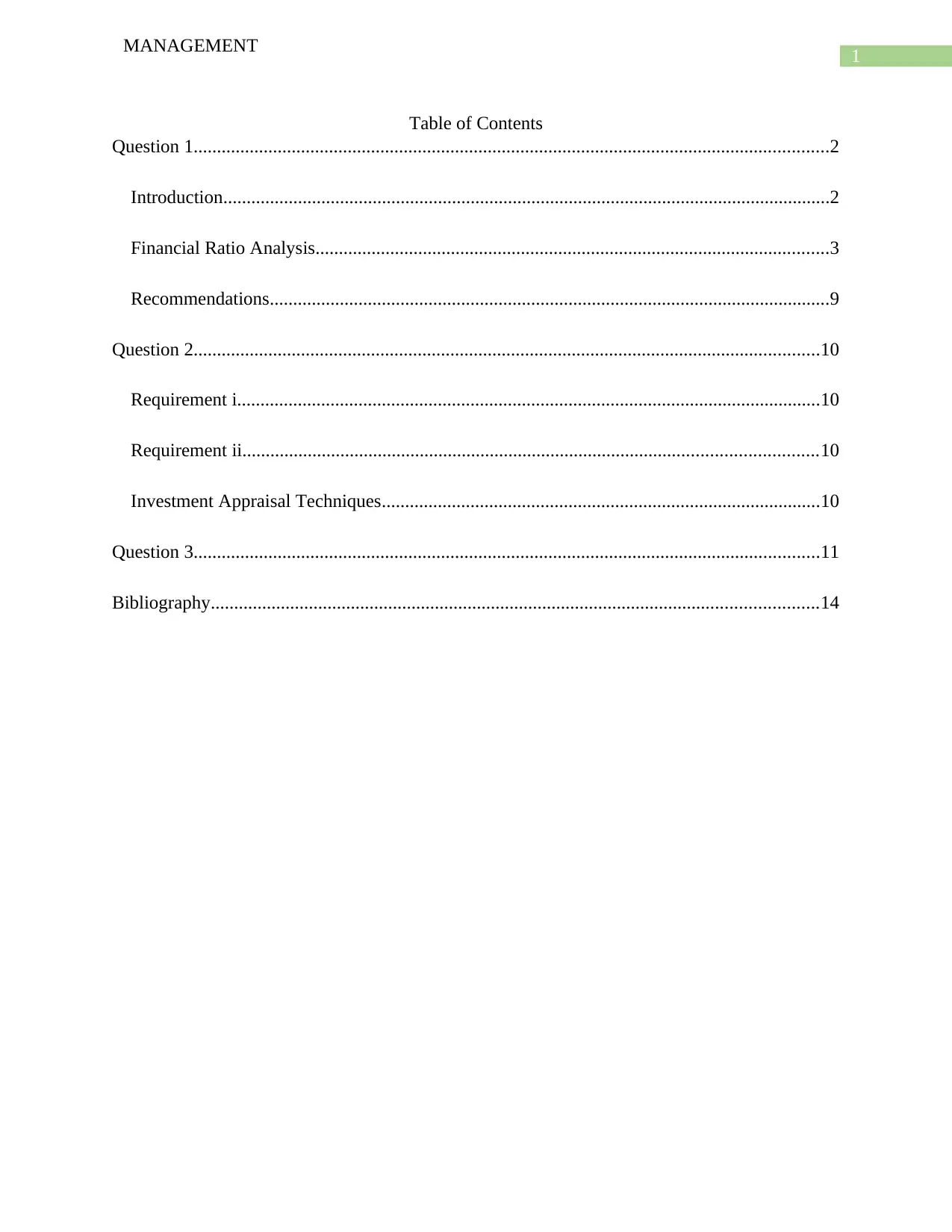
1
MANAGEMENT
Table of Contents
Question 1........................................................................................................................................2
Introduction..................................................................................................................................2
Financial Ratio Analysis..............................................................................................................3
Recommendations........................................................................................................................9
Question 2......................................................................................................................................10
Requirement i.............................................................................................................................10
Requirement ii...........................................................................................................................10
Investment Appraisal Techniques..............................................................................................10
Question 3......................................................................................................................................11
Bibliography..................................................................................................................................14
MANAGEMENT
Table of Contents
Question 1........................................................................................................................................2
Introduction..................................................................................................................................2
Financial Ratio Analysis..............................................................................................................3
Recommendations........................................................................................................................9
Question 2......................................................................................................................................10
Requirement i.............................................................................................................................10
Requirement ii...........................................................................................................................10
Investment Appraisal Techniques..............................................................................................10
Question 3......................................................................................................................................11
Bibliography..................................................................................................................................14
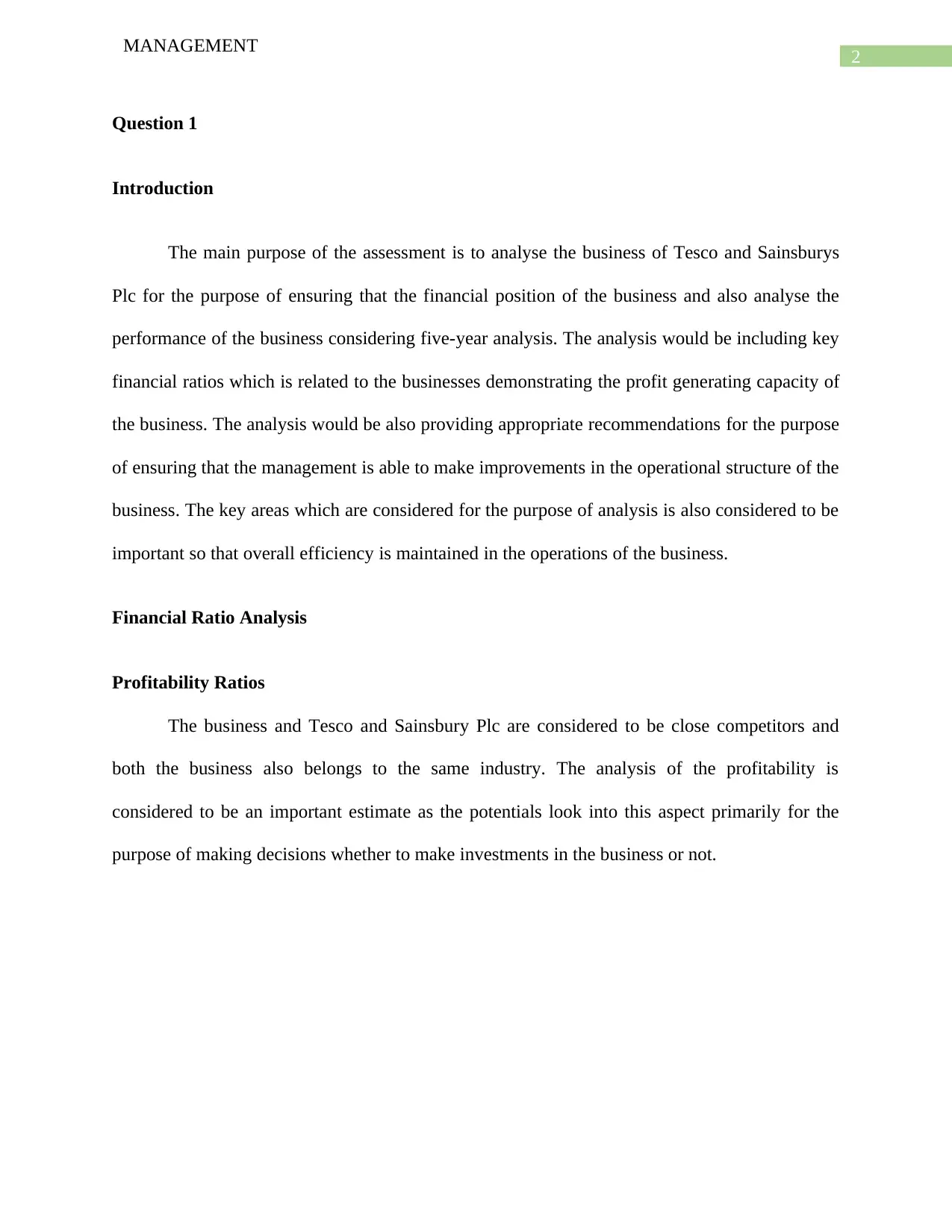
2
MANAGEMENT
Question 1
Introduction
The main purpose of the assessment is to analyse the business of Tesco and Sainsburys
Plc for the purpose of ensuring that the financial position of the business and also analyse the
performance of the business considering five-year analysis. The analysis would be including key
financial ratios which is related to the businesses demonstrating the profit generating capacity of
the business. The analysis would be also providing appropriate recommendations for the purpose
of ensuring that the management is able to make improvements in the operational structure of the
business. The key areas which are considered for the purpose of analysis is also considered to be
important so that overall efficiency is maintained in the operations of the business.
Financial Ratio Analysis
Profitability Ratios
The business and Tesco and Sainsbury Plc are considered to be close competitors and
both the business also belongs to the same industry. The analysis of the profitability is
considered to be an important estimate as the potentials look into this aspect primarily for the
purpose of making decisions whether to make investments in the business or not.
MANAGEMENT
Question 1
Introduction
The main purpose of the assessment is to analyse the business of Tesco and Sainsburys
Plc for the purpose of ensuring that the financial position of the business and also analyse the
performance of the business considering five-year analysis. The analysis would be including key
financial ratios which is related to the businesses demonstrating the profit generating capacity of
the business. The analysis would be also providing appropriate recommendations for the purpose
of ensuring that the management is able to make improvements in the operational structure of the
business. The key areas which are considered for the purpose of analysis is also considered to be
important so that overall efficiency is maintained in the operations of the business.
Financial Ratio Analysis
Profitability Ratios
The business and Tesco and Sainsbury Plc are considered to be close competitors and
both the business also belongs to the same industry. The analysis of the profitability is
considered to be an important estimate as the potentials look into this aspect primarily for the
purpose of making decisions whether to make investments in the business or not.
⊘ This is a preview!⊘
Do you want full access?
Subscribe today to unlock all pages.

Trusted by 1+ million students worldwide

3
MANAGEMENT
Figure 1a: (Profitability Ratios for Sainsbury’s Plc)
Figure 1b: (Profitability Ratios for Tesco Plc)
MANAGEMENT
Figure 1a: (Profitability Ratios for Sainsbury’s Plc)
Figure 1b: (Profitability Ratios for Tesco Plc)
Paraphrase This Document
Need a fresh take? Get an instant paraphrase of this document with our AI Paraphraser
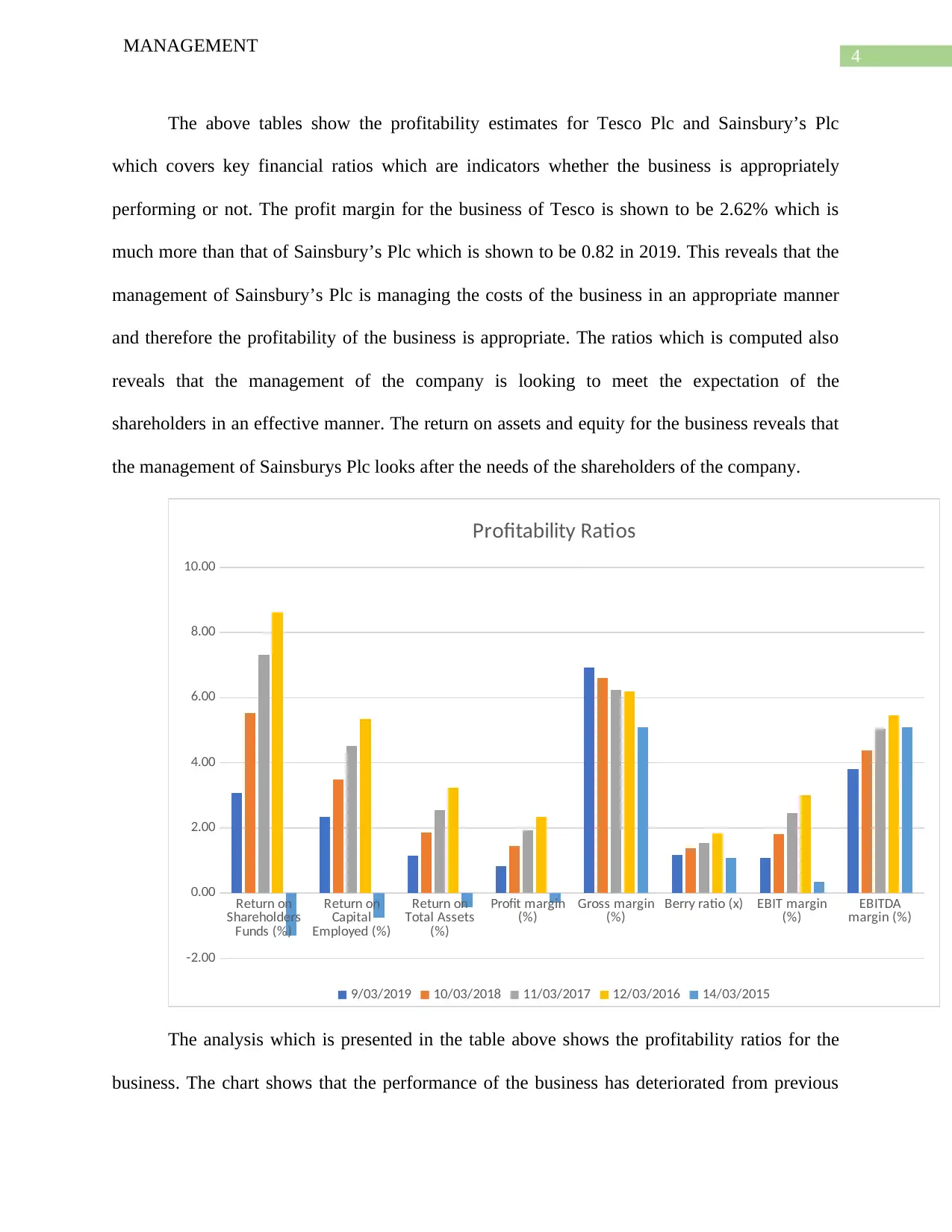
4
MANAGEMENT
The above tables show the profitability estimates for Tesco Plc and Sainsbury’s Plc
which covers key financial ratios which are indicators whether the business is appropriately
performing or not. The profit margin for the business of Tesco is shown to be 2.62% which is
much more than that of Sainsbury’s Plc which is shown to be 0.82 in 2019. This reveals that the
management of Sainsbury’s Plc is managing the costs of the business in an appropriate manner
and therefore the profitability of the business is appropriate. The ratios which is computed also
reveals that the management of the company is looking to meet the expectation of the
shareholders in an effective manner. The return on assets and equity for the business reveals that
the management of Sainsburys Plc looks after the needs of the shareholders of the company.
Return on
Shareholders
Funds (%)
Return on
Capital
Employed (%)
Return on
Total Assets
(%)
Profit margin
(%) Gross margin
(%) Berry ratio (x) EBIT margin
(%) EBITDA
margin (%)
-2.00
0.00
2.00
4.00
6.00
8.00
10.00
Profitability Ratios
9/03/2019 10/03/2018 11/03/2017 12/03/2016 14/03/2015
The analysis which is presented in the table above shows the profitability ratios for the
business. The chart shows that the performance of the business has deteriorated from previous
MANAGEMENT
The above tables show the profitability estimates for Tesco Plc and Sainsbury’s Plc
which covers key financial ratios which are indicators whether the business is appropriately
performing or not. The profit margin for the business of Tesco is shown to be 2.62% which is
much more than that of Sainsbury’s Plc which is shown to be 0.82 in 2019. This reveals that the
management of Sainsbury’s Plc is managing the costs of the business in an appropriate manner
and therefore the profitability of the business is appropriate. The ratios which is computed also
reveals that the management of the company is looking to meet the expectation of the
shareholders in an effective manner. The return on assets and equity for the business reveals that
the management of Sainsburys Plc looks after the needs of the shareholders of the company.
Return on
Shareholders
Funds (%)
Return on
Capital
Employed (%)
Return on
Total Assets
(%)
Profit margin
(%) Gross margin
(%) Berry ratio (x) EBIT margin
(%) EBITDA
margin (%)
-2.00
0.00
2.00
4.00
6.00
8.00
10.00
Profitability Ratios
9/03/2019 10/03/2018 11/03/2017 12/03/2016 14/03/2015
The analysis which is presented in the table above shows the profitability ratios for the
business. The chart shows that the performance of the business has deteriorated from previous
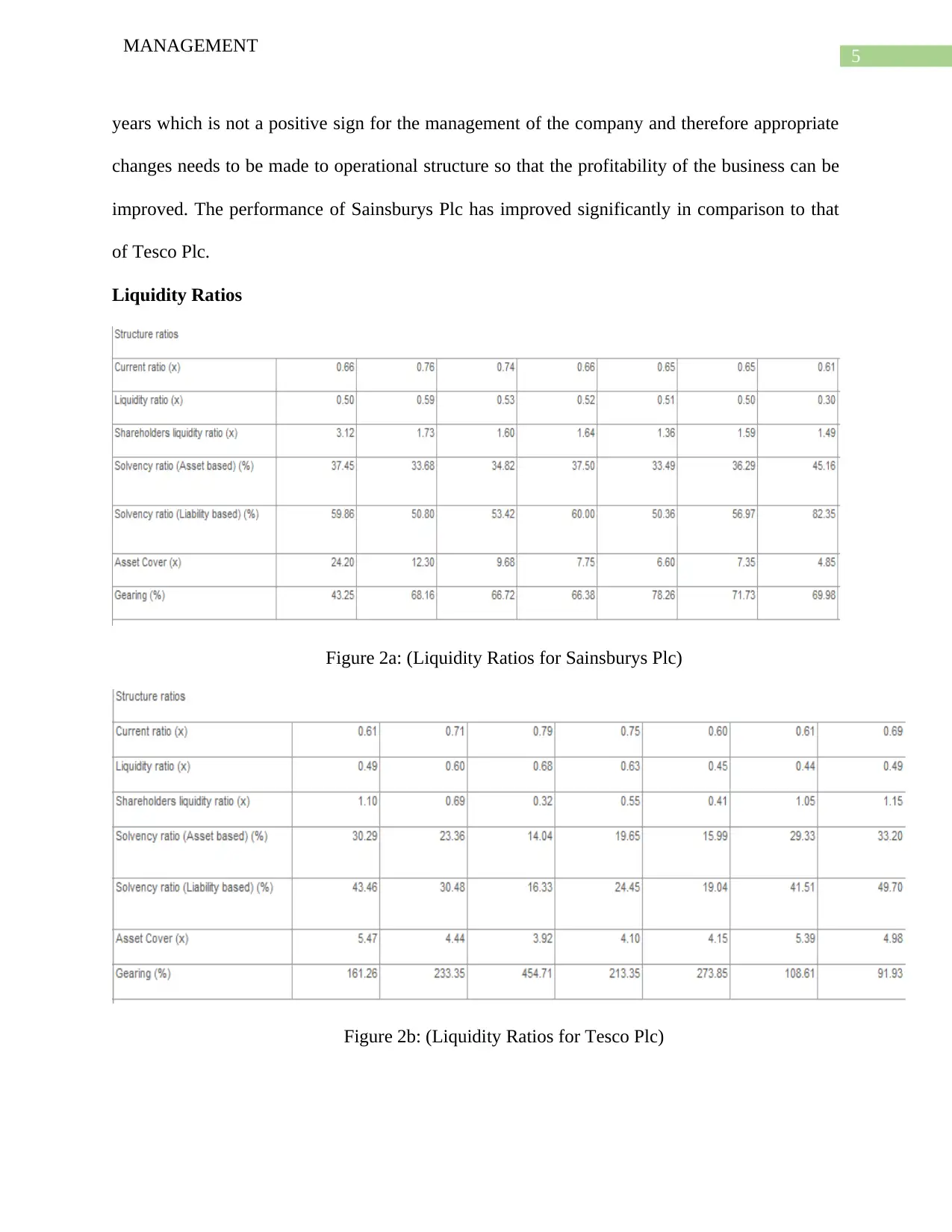
5
MANAGEMENT
years which is not a positive sign for the management of the company and therefore appropriate
changes needs to be made to operational structure so that the profitability of the business can be
improved. The performance of Sainsburys Plc has improved significantly in comparison to that
of Tesco Plc.
Liquidity Ratios
Figure 2a: (Liquidity Ratios for Sainsburys Plc)
Figure 2b: (Liquidity Ratios for Tesco Plc)
MANAGEMENT
years which is not a positive sign for the management of the company and therefore appropriate
changes needs to be made to operational structure so that the profitability of the business can be
improved. The performance of Sainsburys Plc has improved significantly in comparison to that
of Tesco Plc.
Liquidity Ratios
Figure 2a: (Liquidity Ratios for Sainsburys Plc)
Figure 2b: (Liquidity Ratios for Tesco Plc)
⊘ This is a preview!⊘
Do you want full access?
Subscribe today to unlock all pages.

Trusted by 1+ million students worldwide
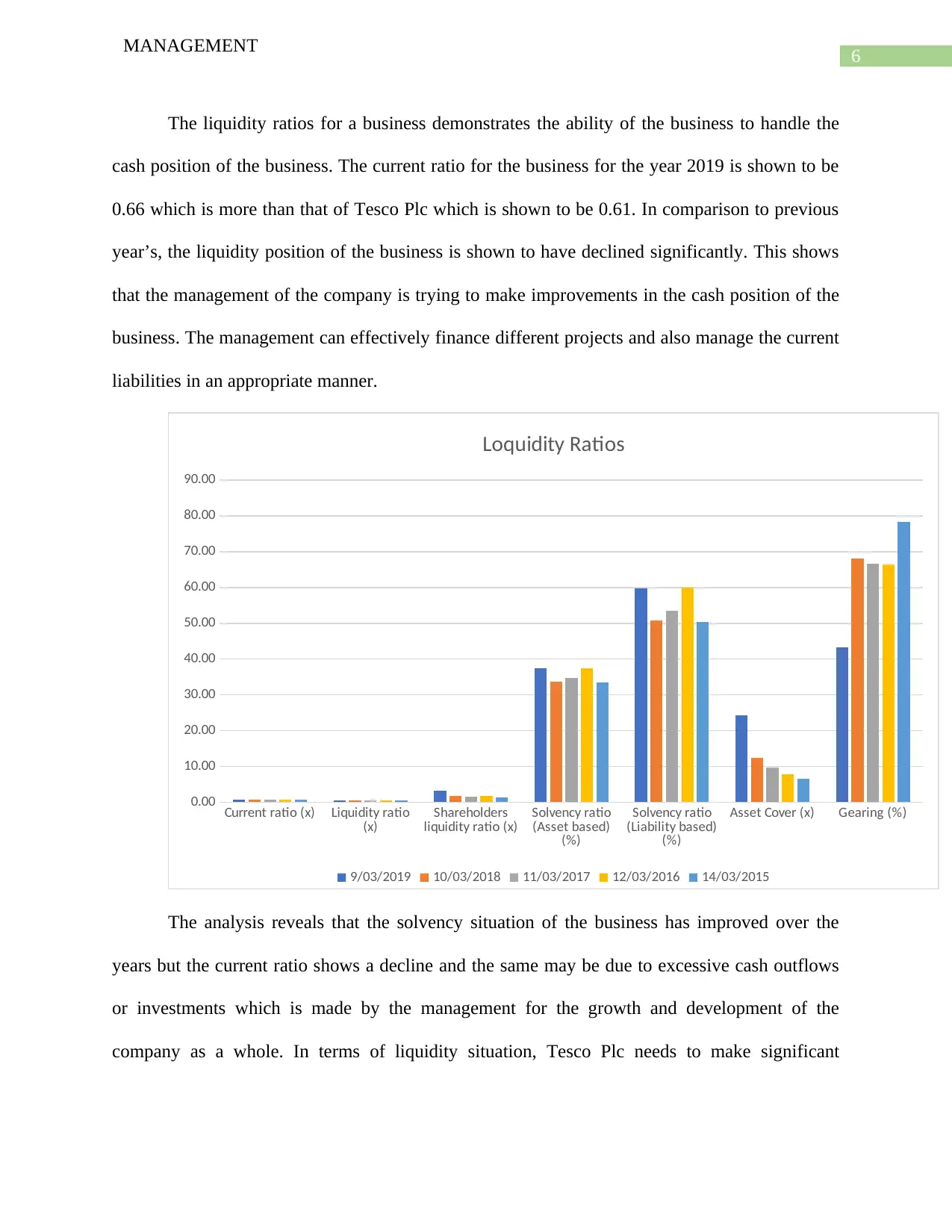
6
MANAGEMENT
The liquidity ratios for a business demonstrates the ability of the business to handle the
cash position of the business. The current ratio for the business for the year 2019 is shown to be
0.66 which is more than that of Tesco Plc which is shown to be 0.61. In comparison to previous
year’s, the liquidity position of the business is shown to have declined significantly. This shows
that the management of the company is trying to make improvements in the cash position of the
business. The management can effectively finance different projects and also manage the current
liabilities in an appropriate manner.
Current ratio (x) Liquidity ratio
(x) Shareholders
liquidity ratio (x) Solvency ratio
(Asset based)
(%)
Solvency ratio
(Liability based)
(%)
Asset Cover (x) Gearing (%)
0.00
10.00
20.00
30.00
40.00
50.00
60.00
70.00
80.00
90.00
Loquidity Ratios
9/03/2019 10/03/2018 11/03/2017 12/03/2016 14/03/2015
The analysis reveals that the solvency situation of the business has improved over the
years but the current ratio shows a decline and the same may be due to excessive cash outflows
or investments which is made by the management for the growth and development of the
company as a whole. In terms of liquidity situation, Tesco Plc needs to make significant
MANAGEMENT
The liquidity ratios for a business demonstrates the ability of the business to handle the
cash position of the business. The current ratio for the business for the year 2019 is shown to be
0.66 which is more than that of Tesco Plc which is shown to be 0.61. In comparison to previous
year’s, the liquidity position of the business is shown to have declined significantly. This shows
that the management of the company is trying to make improvements in the cash position of the
business. The management can effectively finance different projects and also manage the current
liabilities in an appropriate manner.
Current ratio (x) Liquidity ratio
(x) Shareholders
liquidity ratio (x) Solvency ratio
(Asset based)
(%)
Solvency ratio
(Liability based)
(%)
Asset Cover (x) Gearing (%)
0.00
10.00
20.00
30.00
40.00
50.00
60.00
70.00
80.00
90.00
Loquidity Ratios
9/03/2019 10/03/2018 11/03/2017 12/03/2016 14/03/2015
The analysis reveals that the solvency situation of the business has improved over the
years but the current ratio shows a decline and the same may be due to excessive cash outflows
or investments which is made by the management for the growth and development of the
company as a whole. In terms of liquidity situation, Tesco Plc needs to make significant
Paraphrase This Document
Need a fresh take? Get an instant paraphrase of this document with our AI Paraphraser
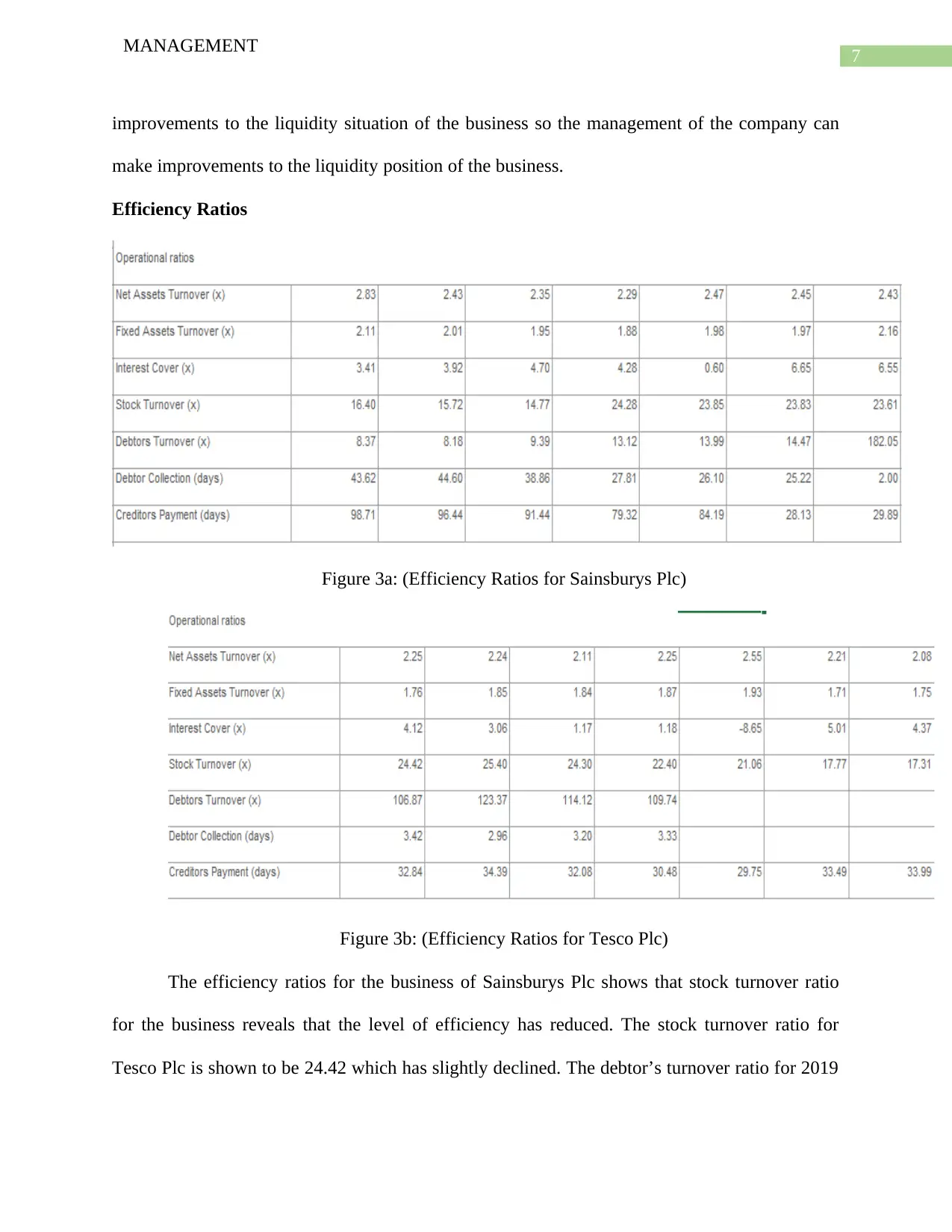
7
MANAGEMENT
improvements to the liquidity situation of the business so the management of the company can
make improvements to the liquidity position of the business.
Efficiency Ratios
Figure 3a: (Efficiency Ratios for Sainsburys Plc)
Figure 3b: (Efficiency Ratios for Tesco Plc)
The efficiency ratios for the business of Sainsburys Plc shows that stock turnover ratio
for the business reveals that the level of efficiency has reduced. The stock turnover ratio for
Tesco Plc is shown to be 24.42 which has slightly declined. The debtor’s turnover ratio for 2019
MANAGEMENT
improvements to the liquidity situation of the business so the management of the company can
make improvements to the liquidity position of the business.
Efficiency Ratios
Figure 3a: (Efficiency Ratios for Sainsburys Plc)
Figure 3b: (Efficiency Ratios for Tesco Plc)
The efficiency ratios for the business of Sainsburys Plc shows that stock turnover ratio
for the business reveals that the level of efficiency has reduced. The stock turnover ratio for
Tesco Plc is shown to be 24.42 which has slightly declined. The debtor’s turnover ratio for 2019
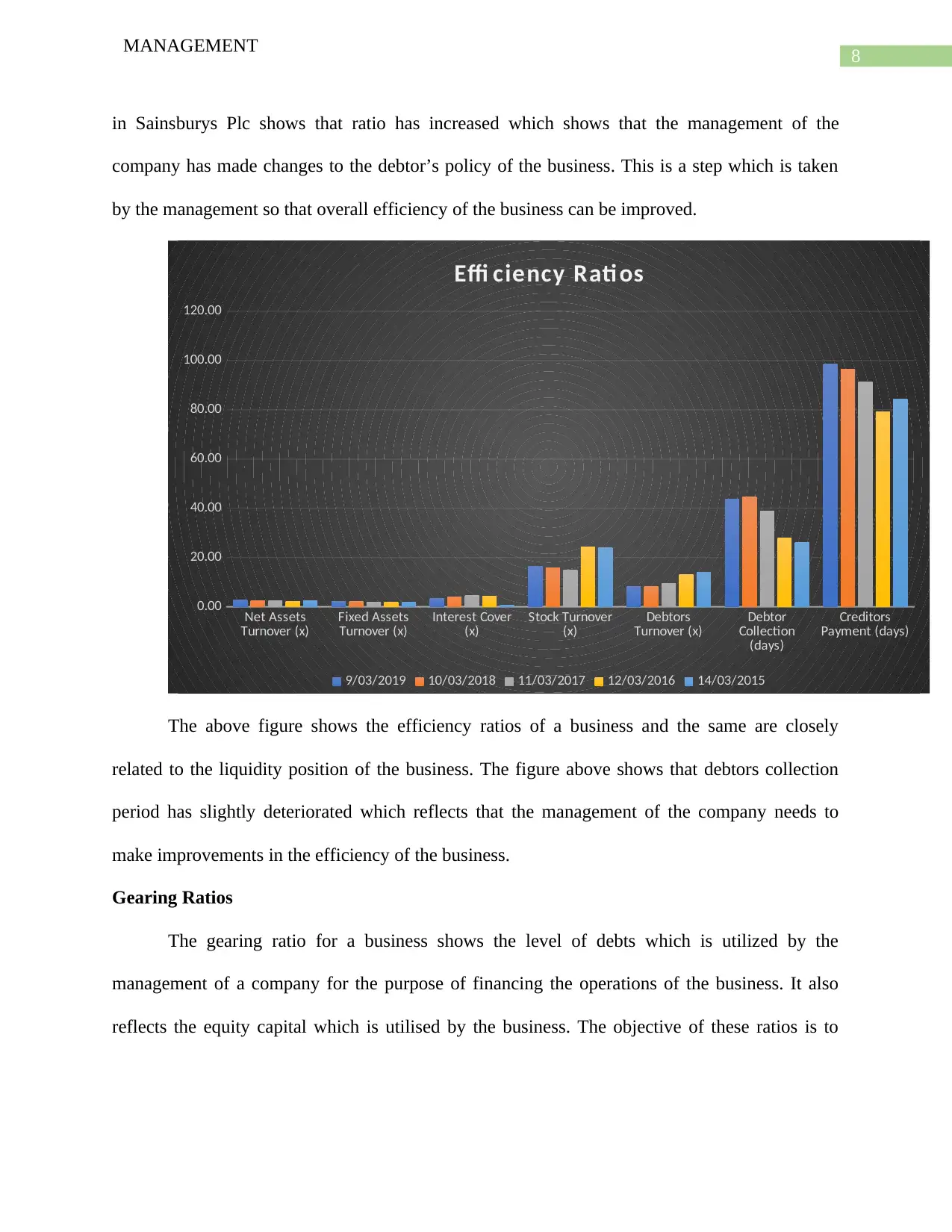
8
MANAGEMENT
in Sainsburys Plc shows that ratio has increased which shows that the management of the
company has made changes to the debtor’s policy of the business. This is a step which is taken
by the management so that overall efficiency of the business can be improved.
Net Assets
Turnover (x)
Fixed Assets
Turnover (x)
Interest Cover
(x)
Stock Turnover
(x)
Debtors
Turnover (x)
Debtor
Collection
(days)
Creditors
Payment (days)
0.00
20.00
40.00
60.00
80.00
100.00
120.00
Effi ciency Rati os
9/03/2019 10/03/2018 11/03/2017 12/03/2016 14/03/2015
The above figure shows the efficiency ratios of a business and the same are closely
related to the liquidity position of the business. The figure above shows that debtors collection
period has slightly deteriorated which reflects that the management of the company needs to
make improvements in the efficiency of the business.
Gearing Ratios
The gearing ratio for a business shows the level of debts which is utilized by the
management of a company for the purpose of financing the operations of the business. It also
reflects the equity capital which is utilised by the business. The objective of these ratios is to
MANAGEMENT
in Sainsburys Plc shows that ratio has increased which shows that the management of the
company has made changes to the debtor’s policy of the business. This is a step which is taken
by the management so that overall efficiency of the business can be improved.
Net Assets
Turnover (x)
Fixed Assets
Turnover (x)
Interest Cover
(x)
Stock Turnover
(x)
Debtors
Turnover (x)
Debtor
Collection
(days)
Creditors
Payment (days)
0.00
20.00
40.00
60.00
80.00
100.00
120.00
Effi ciency Rati os
9/03/2019 10/03/2018 11/03/2017 12/03/2016 14/03/2015
The above figure shows the efficiency ratios of a business and the same are closely
related to the liquidity position of the business. The figure above shows that debtors collection
period has slightly deteriorated which reflects that the management of the company needs to
make improvements in the efficiency of the business.
Gearing Ratios
The gearing ratio for a business shows the level of debts which is utilized by the
management of a company for the purpose of financing the operations of the business. It also
reflects the equity capital which is utilised by the business. The objective of these ratios is to
⊘ This is a preview!⊘
Do you want full access?
Subscribe today to unlock all pages.

Trusted by 1+ million students worldwide

9
MANAGEMENT
revela if the business is able to create an appropriate capital mix for the purpose of maintaining a
healthy risk return balance.
Figure 4a: (Gearing Ratios for Sainsburys Plc)
Figure 4b: (Gearing Ratios for Tesco Plc)
The above analysis reveals that the management of Tesco Plc is trying to reduce the debt
capital of the business and therefore appropriate steps are being taken so that the overall risks of
the business can be managed appropriately. In comparison with Tesco Plc, Sainsburys Plc
utilizes lower amount of debt capital which shows that the management of the company aims to
manage the risks of the business in an appropriate manner so that risk free operations can be
undertaken for generating revenue.
MANAGEMENT
revela if the business is able to create an appropriate capital mix for the purpose of maintaining a
healthy risk return balance.
Figure 4a: (Gearing Ratios for Sainsburys Plc)
Figure 4b: (Gearing Ratios for Tesco Plc)
The above analysis reveals that the management of Tesco Plc is trying to reduce the debt
capital of the business and therefore appropriate steps are being taken so that the overall risks of
the business can be managed appropriately. In comparison with Tesco Plc, Sainsburys Plc
utilizes lower amount of debt capital which shows that the management of the company aims to
manage the risks of the business in an appropriate manner so that risk free operations can be
undertaken for generating revenue.
Paraphrase This Document
Need a fresh take? Get an instant paraphrase of this document with our AI Paraphraser
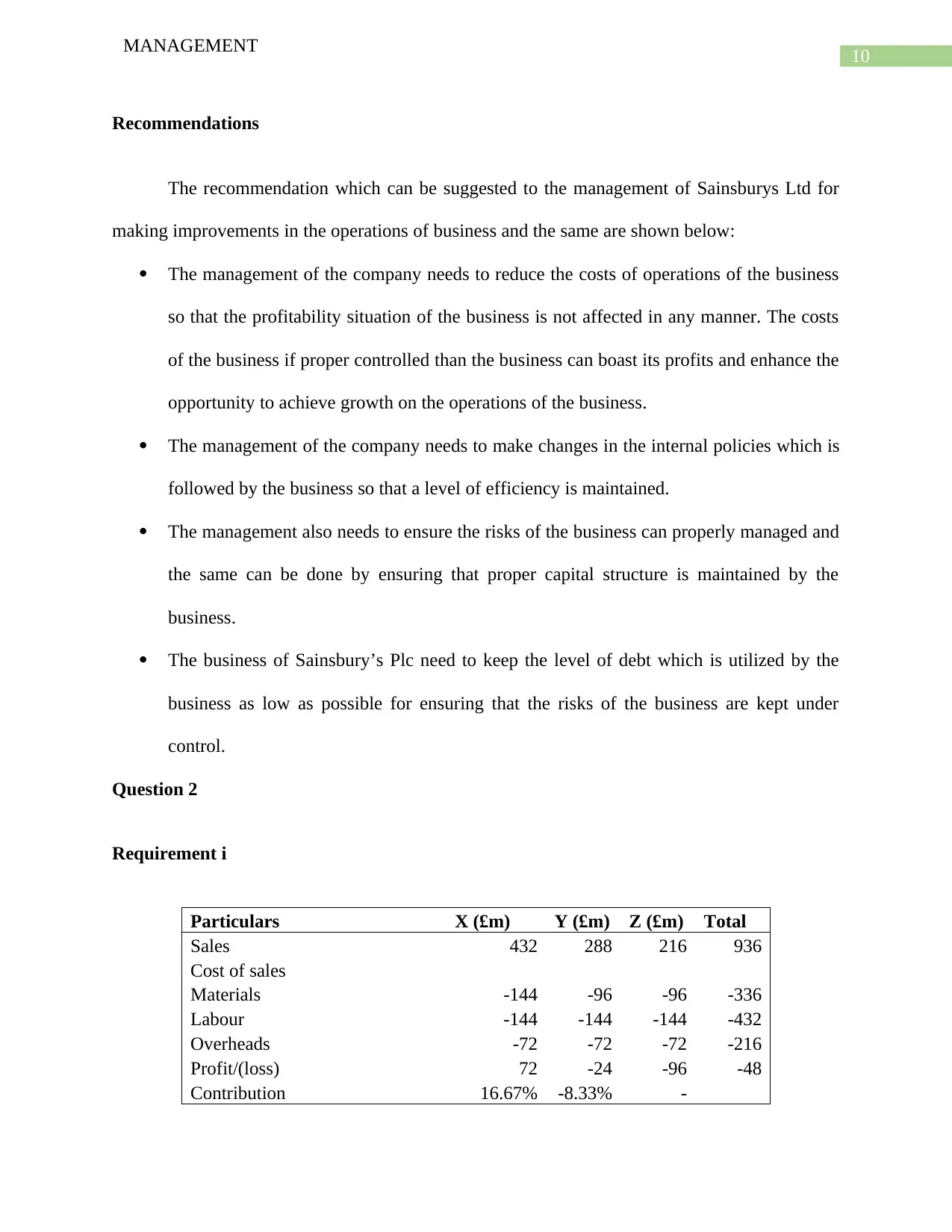
10
MANAGEMENT
Recommendations
The recommendation which can be suggested to the management of Sainsburys Ltd for
making improvements in the operations of business and the same are shown below:
The management of the company needs to reduce the costs of operations of the business
so that the profitability situation of the business is not affected in any manner. The costs
of the business if proper controlled than the business can boast its profits and enhance the
opportunity to achieve growth on the operations of the business.
The management of the company needs to make changes in the internal policies which is
followed by the business so that a level of efficiency is maintained.
The management also needs to ensure the risks of the business can properly managed and
the same can be done by ensuring that proper capital structure is maintained by the
business.
The business of Sainsbury’s Plc need to keep the level of debt which is utilized by the
business as low as possible for ensuring that the risks of the business are kept under
control.
Question 2
Requirement i
Particulars X (£m) Y (£m) Z (£m) Total
Sales 432 288 216 936
Cost of sales
Materials -144 -96 -96 -336
Labour -144 -144 -144 -432
Overheads -72 -72 -72 -216
Profit/(loss) 72 -24 -96 -48
Contribution 16.67% -8.33% -
MANAGEMENT
Recommendations
The recommendation which can be suggested to the management of Sainsburys Ltd for
making improvements in the operations of business and the same are shown below:
The management of the company needs to reduce the costs of operations of the business
so that the profitability situation of the business is not affected in any manner. The costs
of the business if proper controlled than the business can boast its profits and enhance the
opportunity to achieve growth on the operations of the business.
The management of the company needs to make changes in the internal policies which is
followed by the business so that a level of efficiency is maintained.
The management also needs to ensure the risks of the business can properly managed and
the same can be done by ensuring that proper capital structure is maintained by the
business.
The business of Sainsbury’s Plc need to keep the level of debt which is utilized by the
business as low as possible for ensuring that the risks of the business are kept under
control.
Question 2
Requirement i
Particulars X (£m) Y (£m) Z (£m) Total
Sales 432 288 216 936
Cost of sales
Materials -144 -96 -96 -336
Labour -144 -144 -144 -432
Overheads -72 -72 -72 -216
Profit/(loss) 72 -24 -96 -48
Contribution 16.67% -8.33% -
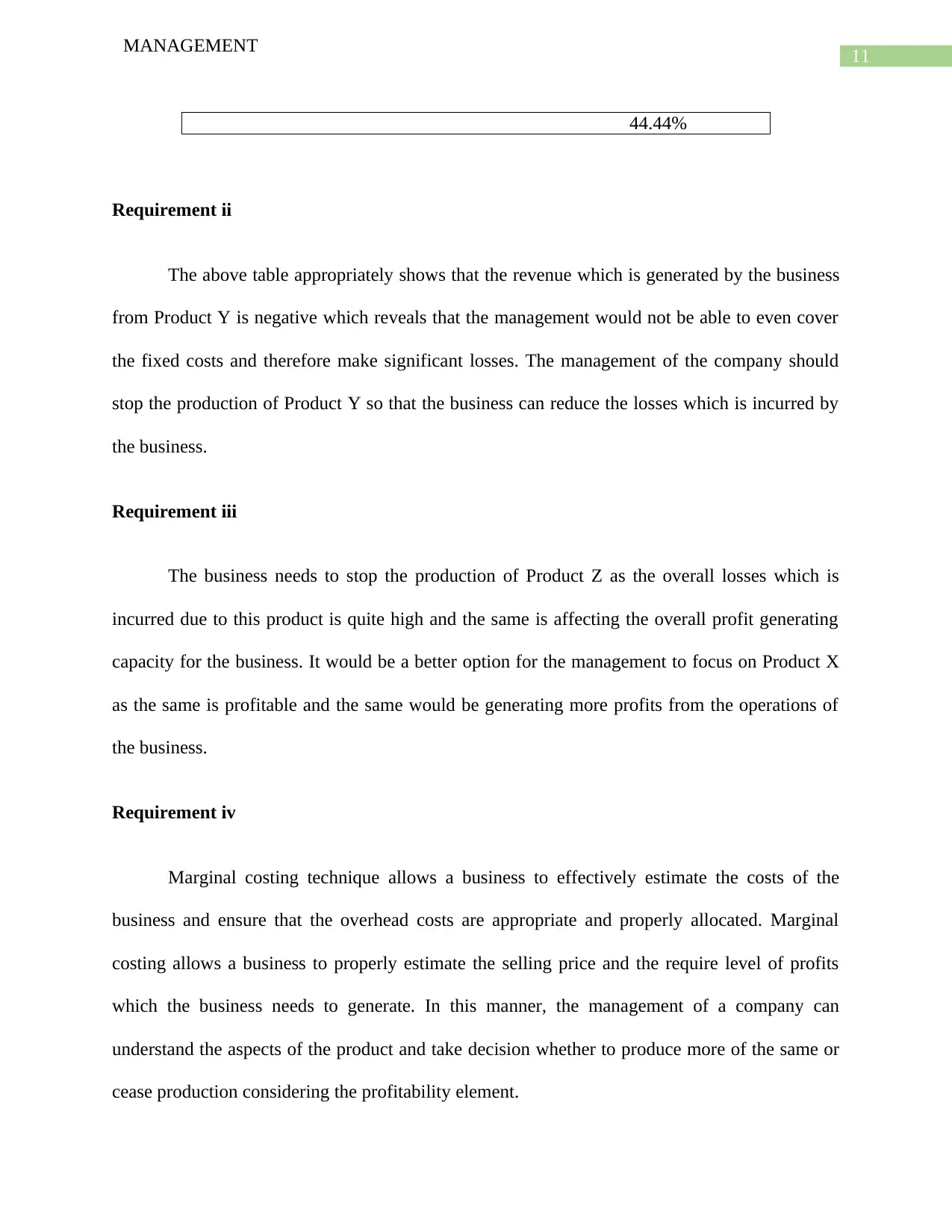
11
MANAGEMENT
44.44%
Requirement ii
The above table appropriately shows that the revenue which is generated by the business
from Product Y is negative which reveals that the management would not be able to even cover
the fixed costs and therefore make significant losses. The management of the company should
stop the production of Product Y so that the business can reduce the losses which is incurred by
the business.
Requirement iii
The business needs to stop the production of Product Z as the overall losses which is
incurred due to this product is quite high and the same is affecting the overall profit generating
capacity for the business. It would be a better option for the management to focus on Product X
as the same is profitable and the same would be generating more profits from the operations of
the business.
Requirement iv
Marginal costing technique allows a business to effectively estimate the costs of the
business and ensure that the overhead costs are appropriate and properly allocated. Marginal
costing allows a business to properly estimate the selling price and the require level of profits
which the business needs to generate. In this manner, the management of a company can
understand the aspects of the product and take decision whether to produce more of the same or
cease production considering the profitability element.
MANAGEMENT
44.44%
Requirement ii
The above table appropriately shows that the revenue which is generated by the business
from Product Y is negative which reveals that the management would not be able to even cover
the fixed costs and therefore make significant losses. The management of the company should
stop the production of Product Y so that the business can reduce the losses which is incurred by
the business.
Requirement iii
The business needs to stop the production of Product Z as the overall losses which is
incurred due to this product is quite high and the same is affecting the overall profit generating
capacity for the business. It would be a better option for the management to focus on Product X
as the same is profitable and the same would be generating more profits from the operations of
the business.
Requirement iv
Marginal costing technique allows a business to effectively estimate the costs of the
business and ensure that the overhead costs are appropriate and properly allocated. Marginal
costing allows a business to properly estimate the selling price and the require level of profits
which the business needs to generate. In this manner, the management of a company can
understand the aspects of the product and take decision whether to produce more of the same or
cease production considering the profitability element.
⊘ This is a preview!⊘
Do you want full access?
Subscribe today to unlock all pages.

Trusted by 1+ million students worldwide
1 out of 17
Related Documents
Your All-in-One AI-Powered Toolkit for Academic Success.
+13062052269
info@desklib.com
Available 24*7 on WhatsApp / Email
![[object Object]](/_next/static/media/star-bottom.7253800d.svg)
Unlock your academic potential
Copyright © 2020–2025 A2Z Services. All Rights Reserved. Developed and managed by ZUCOL.





